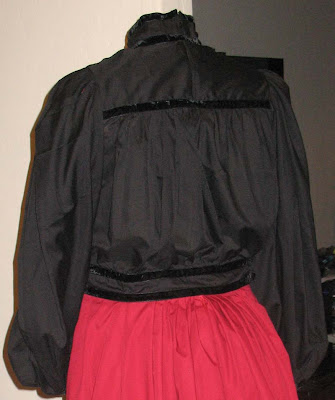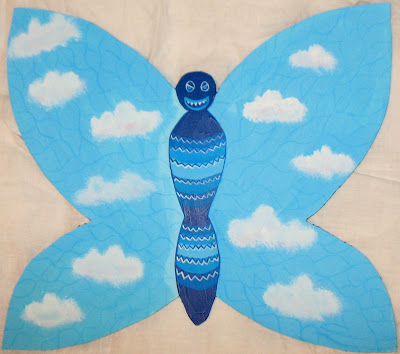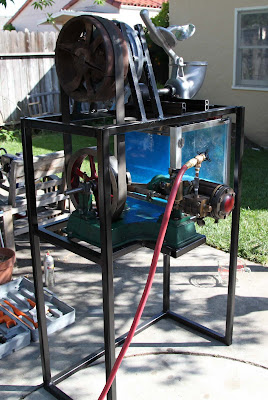
I am going to be serving tea in the
Kinetic Steam Works "Arsenic and Old Lace Tearoom" at the
Edwardian Ball next weekend in San Francisco and I needed an outfit to wear. I've never been to an
Edwardian Ball so I looked at pictures from past events to see how period accurately people are dressed. The answer is not at all - there's lots of stuff that is really earlier Victorian, some steampunk, and some just plain weird. Knowing that made it much easier to put my outfit together because I can do a period look without worrying about being completely period correct.
I didn't have any patterns and wasn't willing to lay out money to buy one. I wanted to make this dress as cheaply as possible but still have it look nice. I decided to go with a daytime look, even though it is an evening ball, because I am primarily going to be a cafe worker, not a ballroom dancer. Coincidentally, daytime clothing type fabric is less expensive and I admit this was my primary reason for choosing it. I also didn't know what I was doing and if the outfit was a colossal failure I would be out less money.
I spent one week net surfing to come up with a rough design and one week actually sewing (I seem to specialize in the "one week wonder" dress).
For the skirt I chose to make a five panel skirt because it was simpler to sew than a seven or nine panel skirt. The front is flat, just a couple small tucks. All five panels are roughly trapezoidal. The side panels have a tuck to accommodate my hips. The back panels are pleated to the center back to create some "pouf". I practiced making the skirt by making a petticoat first, it is made exactly the same as the skirt except it opens to the side. The skirt opens in the back and has a zip to make it easier to get into.

I was very anxious about making the jacket as I have no experience with that kind of tailoring. A few unsuccessful trial pieces ended up on the scrap heap and by the end I had abandoned my ideal of perfection and was taking shortcuts, skipping all the hand sewn finishing I had planned. The front gapes open but since the pigeon breasted look was fashionable at this time and I planned to sew a poufy blouse I decided I could live with this. Lucky me I wasn't doing Victorian!

The blouse is a yoke top with stand up collar, fitted waist and cuffs, and everything loose and bloused in between. Both the sleeves and bodice are gathered at the top and bottom. There is a zip on the side inside the side seam and one in the yoke in the back. This lets me get head through the top and saves me from having to sew buttonholes, which my ancient sewing machine doesn't do and I really really hate to do by hand (plus it was a big time saver). All the machine topstitching is covered with the wonderful velvet trim.



I will be wearing a corset, one that I made a couple of years ago for a Halloween outfit. I used the
Custom Corset Pattern Generator (thank you Drea Leed!) to make a fairly generic corset. The important thing is that is makes the outfit look better, and because I am wearing it I stand up straighter. This helps me look more period I think. Modern slouchiness will ruin the most perfectly period outfit.
The corset is made of cotton canvas and boned with the bones of the plastic whale (aka zip ties). I have seen a real vintage whale bone, and it is remarkably similar to a zip tie.
Materials: sourced from the Scary Fabric Store (really Fabrics R Us in east San Jose). If you've ever been to a fabric market in Asia, that's what this store is like. Bolts are piled high, inventory changes so check back often, prices and content rarely marked. But you can get good deals there, and it is getting harder and harder to find good dress fabric at the mainstream fabric stores, so sad.
$10 Heavily starched white poly/cotton, 3 yards @ $3/yard (I included tax estimates in my totals)
$23 Red mystery fabric, content unknown (probably poly/cotton), medium weight, 7 yards @ $3/yard
$15 Black mystery fabric, content unknown (probably poly/cotton, medium-heavy weight, 3-4 yards @ $4/yard (I used this for
interlining, mistakes, and an idea I abandoned)
$37 3/4 inch synthetic velvet trim, 22 yards. The first time I was charged $2/yard, the second time I was charged $1/yard.
That's how it happens sometimes at the Scary Fabric Store.
$14 Black blouse fabric, a very light, slightly translucent mystery fabric (probably poly/cotton), 4 yards @ $3/yard
Total: $99I made so many mistakes with this oufit, I could spend an hour pointing them out. But overall it looks good, it fits me well enough, and I am pleased.




















